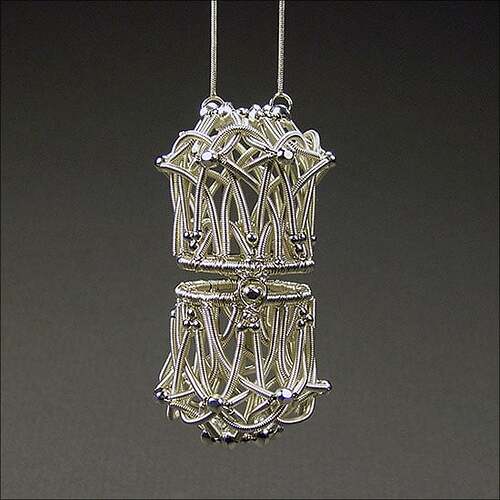Materials: Fine silver, sterling silver
Dimensions: Pendant: L 6.1 cm x W 3.2 cm (L 2.4" x W 1.25") Chain: 88 cm (34.6")
In Hinduism, the lingam is a symbol of Shiva. Worn in a similar fashion as a Christian cross, the intent is to draw the blessings of the Higher Power to the wearer. I chose to interpret this symbol as a pomander worn over the solar plexus, allowing the wearer to carry a prayer or fresh flowers within: a reminder to always recognize the Source of all life’s gifts.
Dedicated to my friend and fellow artist, Perri Jackson, whose loving spirit inspired and informed this piece.
Photo credit: Dianne Karg Baron
Dianne Karg Baron
Oshawa, Ontario. Canada
When I was young, I loved doing “blind” line drawings - putting the pen down on the paper, but only looking at my subject while moving my hand unseen around the page. I wouldn’t know what the drawing would look like until I was finished. In many ways, the work I do in wire is much like doing those drawings - I start at one end and keep going, not always knowing how it’s going to turn out. But, the possibilities are virtually endless and the excitement I feel working with wire has never gone away, even after years of bending, linking, twisting, weaving, hammering, fusing, crocheting and knitting my way through many kilograms of metal. My work takes influences from Celtic and Eastern mysticism, from modernism and architecture, and line drawing and calligraphy. I’m still exploring, still experimenting, still discovering what wire can do. It’s a joyful journey.
These containers and vessels definitely hold their place in the world of stunning art objects as well as in the world of metalsmithing.
Since the dawn of time humans have created containers to hold things that were important to them, from large vessels to hold food and harvests to intimate containers for small precious things. They might hold memories, ashes, medicine, beverage, fruit or food - but all spring from the imagination and skill of the maker. Some have specific religious functions, some are meant for everyday use. When one thinks of a vessel or container the inclination is to think of something with solid walls - yet many of these works involve the exploration of positive and negative space, and the use of negative space to help create the illusion of the wall of the vessel.
As the world’s largest jewelry related internet site, Ganoksin strives to develop exhibitions showcasing work from around the world. This exhibition was open to all metalsmiths, professional and amateur, advanced and beginner. Participants are from The Netherlands, the USA, Canada, Australia, Costa Rica, the United Kingdom, Israel, Hong Kong, Colombia, Romania, Italy, Ireland, Japan, Malaysia and Denmark. While most of the pieces are by an individual metalsmith, some are collaborations, one of three artists spanning 50 years.
In total 319 artists contributed 729 show pieces for the permanent online exhibition.
Objects in the exhibition include boxes, lockets, urns, ash containers, bowls, wine cups, reliquaries, match holders, vases, teapots, pitchers, sugar bowls, baskets, nests, pillboxes, clutches and a range of sculptural forms. A variety of techniques are showcased covering a wide range of metalsmithing techniques. Materials used include everything from gold and silver to less expensive metals. Ornamentation includes the addition of enamel, chasing and repousse’, gemstones and found objects.
The exhibition was curated by Beth Wicker, President of the North Carolina Society of Goldsmiths in the United States, and Adjunct Instructor at Northeastern Technical College in South Carolina. Director of the exhibition is Hanuman Aspler, founder of The Ganoksin Project, the world’s largest internet jewelry site.
